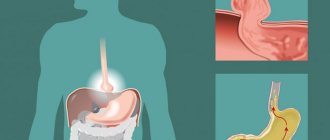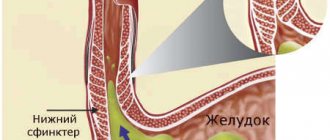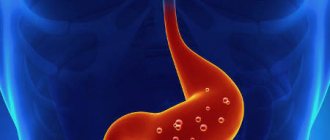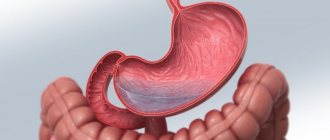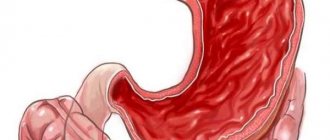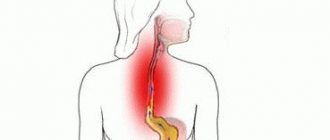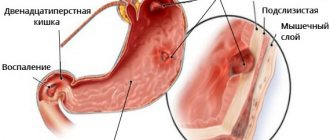Duodeno-gastric reflux – a very unpleasant problem, which is accompanied by feelings of discomfort, pain, burning in the stomach and other unpleasant symptoms. Moreover, this situation is not always pathological. According to statistics, GHD occurs in approximately 15% of people who do not have problems with the digestive system. The reasons for this are unsystematic eating disorders, heavy physical activity, and stress.
Expert opinion
Sevastyanov Roman
General practitioner, hepatologist, gastroenterologist, highest qualification category. Site Expert
We can talk about the disease only in cases where reflux occurs regularly and the patient experiences discomfort for a long period of time. In this case, heartburn may be a symptom of serious gastrointestinal diseases. Therefore, if a burning sensation occurs, you should consult a doctor and undergo an examination, especially if this situation occurs frequently.
Characteristics of the DGR
Duodenogastric reflux is a situation in which the normal process of food movement is disrupted. Initially, in a partially digested state, it enters the duodenum from the stomach. When certain circumstances occur, part of this bolus of food changes its movement and returns back to the stomach.
This occurs as a result of weakening of the pylorus - the sphincter that separates the cavity of the stomach and duodenum. Through the pylorus, food passes from the stomach to the intestines, and the same sphincter prevents its retrograde (reverse) movement. As a result of weakening of the walls of the sphincter, partial entry of the food bolus back into the stomach is observed. This problem is accompanied by unpleasant symptoms that are noticeable to the patient.
Causes of the disease and risk groups
Duodenogastric reflux can occur as a result of various unfavorable causes. These can be either single factors or serious diseases of the digestive system, or abnormalities in the structure of the gastrointestinal tract. The most common reasons include:
- Violation of the diet, when after a long fast a person immediately eats a large portion of food;
- Consumption of foods that increase the acidity of gastric juice, as well as foods that are difficult to digest;
- Motility disorders of the muscle tissue of the stomach or intestines;
- A sharp increase in pressure in the intestines (for example, as a result of heavy lifting, active physical activity);
- Uncontrolled use of certain groups of drugs. First of all, these are choleretic drugs, as well as NSAIDs. Preparations of natural origin containing plant extracts can also have a negative impact on the process of food promotion;
- Features of the structure of the pyloric part of the stomach;
- Congenital anomalies of the development of the child’s digestive system (such disorders arise even during the formation of the food tube, from which the gastrointestinal tract is subsequently formed;
- Stomach diseases in acute or chronic form;
- As a result of endoscopic examinations or surgical operations, the functioning of the stomach and upper intestine may be disrupted, which is accompanied by the appearance of heartburn and GHD;
- Late pregnancy, when an enlarged uterus puts pressure on the abdominal organs, disrupting their function;
- Frequent stress and overwork;
- Excess body weight.
general description
Chronic duodenitis is a disease characterized by inflammatory changes and structural degeneration of the mucous membrane of the duodenum.
Chronic duodenitis is widespread: it accounts for about 25% of all diseases of the gastrointestinal tract. Men are more susceptible to chronic duodenitis: they get sick 2-3 times more often than women.
The cause, as a rule, is systematic, prolonged exposure to the mucous membrane of the duodenum of rough and spicy foods and strong alcoholic drinks. Its place is occupied by prolonged neuropsychic overstrain with a pathological disorder of the nervous regulation of the abdominal organs. Very often, chronic duodenitis occurs together with chronic inflammatory diseases of other organs of the gastrointestinal tract.
Symptoms and manifestations
The symptoms of GHD are not specific, that is, the same signs can appear in other diseases, so differential diagnosis is of great importance, which allows you to accurately identify the problem. Such manifestations are usually classified as:
- A burning sensation and pain in the sternum;
- Belching, sometimes accompanied by a slight release of sour vomit;
- Discomfort when swallowing food or liquid;
- Bad breath, unpleasant taste;
- Feeling of fullness in the stomach, as if it were full;
- Bloating, pain;
- Decreased appetite, rapid satiety;
- Weakness, decreased ability to work.
Prevention
At the first signs of reflux esophagitis and the appearance of symptoms such as heartburn, discomfort after eating, you should consult a doctor. You may need a slight adjustment to your daily routine, nutrition, and habits. On your own, in order to prevent the development of the disease, you can follow simple rules:
- eat little and often;
- never overeat;
- do not lie down after eating or bend over;
- sleep with the headboard or pillow raised;
- avoid heavy straining and heavy lifting after eating;
- reduce or eliminate the consumption of alcohol, strong tea, coffee, spicy foods;
- stop smoking;
- if you are obese, try to lose weight;
- Avoid stressful situations, infectious viral diseases and weakened immunity.
The most important thing: you should not ignore any initial manifestations of the disease or self-medicate and suppress the symptoms. A timely visit to a specialist will help to avoid many problems and serious complications in the future. Chronic diseases of the esophagus are easier to prevent than to treat. When the first signs of reflux esophagitis appear, you need to reconsider your lifestyle, get rid of bad habits and stick to a healthy diet.
source
Was the information helpful? Tell others about us, maybe they need help too.
Stages and characteristic signs
The clinical picture may have varying degrees of severity. It all depends on the stage of development of duodeno-gastric reflux. There are 3 degrees of severity of the pathology, each of them is characterized by certain symptoms:
| 1st degree | 2nd degree | 3rd degree |
| A small amount of bile accumulates in the lower pylorus. At this stage, clinical manifestations may be absent, with the exception of minor discomfort and heaviness that occurs some time after eating. | Bile accumulates in the antrum and fundus. Clinical manifestations of GHD are more pronounced. Severe nagging pain, burning, and sour belching appear. After eating, the patient feels heaviness, bloating, and possible attacks of nausea without gagging. | Bile reflux occurs not only in the lower and upper parts of the stomach, but also reaches the sphincter area that separates the stomach and esophagus. In this case, in addition to the characteristic symptoms, signs such as:
|
Symptoms of pathologies
Esophageal reflux often manifests as heartburn. This condition occurs when the surface of the esophagus is irritated by the acidic environment of the stomach. Discomfort may increase after eating, drinking, or bending over. The following symptoms of pathology are also distinguished:
PAY ATTENTION! Do not prolong gastritis or an ulcer until stomach cancer, it is better to be on the safe side, but this will be necessary. read the story of Galina Savina >>
- belching;
- difficulty swallowing;
- regurgitation;
- stomach pain after eating;
- feeling of a lump in the throat;
- chest pain.
Gastroduodenitis manifests itself depending on the severity of the pathology. There are several main symptoms of the disease:
- pain around the navel and in the left hypochondrium;
- heaviness after eating;
- bitterness in the mouth;
- intestinal disorder;
- bloating;
- sweating;
- loss of physical strength;
- heartburn, belching.
Return to contents
Possible complications and consequences
If GHD occurs on an ongoing basis, this pathology can lead to the development of various complications, many of which pose a real threat to human health and even life:
- Erosion of the gastric mucosa;
- Peptic ulcer;
- Damage to the esophagus (gastroesophageal reflux);
- Stenosis of the lumen of the esophagus, and, as a result, the appearance of obstacles to the normal movement of food;
- Degeneration of the epithelial tissue of the stomach, when it takes the form of intestinal epithelium and loses its functionality;
- Formation of benign or malignant tumors in the stomach.
Diagnosis of reflux esophagitis
The diagnosis of reflux esophagitis can be made by a doctor based on the clinical picture, medical history and complaints. In addition, diagnostic methods such as:
- endoscopic examination of the esophagus with biopsy;
- X-ray examination with contrast agent;
- echography of the esophagus;
- endoscopic ultrasound of the esophagus;
- esophagogastroduodenoscopy;
- esophagomanometry (assessment of peristalsis and contractile activity of the esophagus);
- scintigraphy (detection of disorders of the motor function of the esophagus).
• daily monitoring of the pH environment of the esophageal contents; • omeprazole and other specific tests.
Diagnostic methods
To make a diagnosis, it is not enough just to evaluate the totality of available signs, since they are not specific to a given disease. Therefore, in order to get a more accurate and detailed picture, it is necessary to carry out a number of diagnostic measures:
- Visual examination of the patient, during which signs such as pale skin, yellow coating on the tongue, yellowing of the sclera may appear;
- Palpation of the abdomen to determine signs such as pain, irritability of the skin during touching;
- Listening to the area of the stomach and intestines, during this procedure the doctor can hear characteristic noises that occur during increased peristalsis;
- pH-metry to determine the level of acidity of bile and gastric juice;
- Gastric manometry to assess pressure inside the organ;
- Ultrasound of the abdominal cavity, radiography, FGDS - as auxiliary diagnostic methods to identify possible damage (erosions, ulcers) to the walls of the stomach or upper intestine.
Diagnostics
Making a diagnosis of duodenogastric reflux during a consultation with a gastroenterologist can be difficult, since this disease does not have specific symptoms. Quite often the condition is discovered by chance during examinations for other diseases of the digestive tract.
To verify the diagnosis, a consultation with an endoscopist is required: only he will be able to determine the required scope of examination and make a differential diagnosis with other pathologies of the stomach and duodenum (gastritis with high acidity, erosive gastritis, duodenitis, stomach ulcer). It should be remembered that esophagogastroduodenoscopy itself can cause reflux. A distinctive sign of induced endoscopy and pathological reflux will be the presence of bile in the stomach in the second case.
The most reliable diagnostic method is 24-hour intragastric pH-metry. During the study, all fluctuations in the acidity of gastric juice are recorded, especially those not related to meals. To obtain more accurate results, the study of fluctuations in the pH of gastric juice is carried out over a night period of time, when the patient does not eat or experience physical activity.
Methods for treating duodenogastric reflux
Before prescribing suitable treatment, it is necessary to establish the cause of the problem. So, if reflux has isolated manifestations, it is only necessary to eliminate the provoking factor (in particular, review the diet and diet, give up excessive physical activity, protect yourself from stress and anxiety).
If duodenogastric reflux is a symptom of any disease, the patient needs to be prescribed a set of therapeutic measures, including medication, nutrition and lifestyle correction, physiotherapeutic treatment, and exercise therapy. In severe cases, when GDR has led to the development of serious complications (for example, the formation of cancerous tumors), surgery is prescribed.
Physiotherapy, in particular the use of ultrasound and dynamic currents, allows you to restore damaged stomach cells, return the organ to normal functionality, and eliminate the unpleasant symptoms of the pathological process.
Expert opinion
Tsareva Nadezhda
General practitioner, hepatologist, site expert
Exercise is also an effective adjuvant treatment. Complementing the main treatment regimen. A set of exercises, their intensity and duration are developed by the doctor individually for each patient. The classes are aimed at strengthening the walls of the abdominal cavity and stimulating the motility of the digestive organs.
Treatment
The goal of therapy for this pathology is to normalize the functioning of the duodenum and stomach, as well as the entire gastrointestinal tract. In this case, drug therapy is complemented by a therapeutic diet that excludes the consumption of foods harmful to the digestive tract.
Taking medications is aimed at neutralizing the harmful effects of bile on the gastric mucosa, esophagus and oral cavity, increasing sphincter tone, and quickly removing stomach contents from the body.
Restoration of motility is achieved by prescribing drugs that are opioid receptor agonists in the gastrointestinal tract muscles (Trimedat), proton pump inhibitor drugs (Omez) are responsible for neutralizing the effect of duodenal juice on the gastric mucosa, and for better absorption of food, drugs that block serotonin/dopamine receptors (Cerucal) are prescribed. Finally, drugs from the antacid group (Almagel, Phosphalugel) will help get rid of heartburn.
Duodeno-gastric reflux against the background of superficial gastritis, the mildest form of pathology, can be stopped without drug therapy - with the help of careful diet, but such treatment will be longer and does not guarantee a cure for gastritis.
Drug treatment
To achieve a positive therapeutic result, it is necessary to take medications prescribed by a doctor. Such agents have different actions. This is protecting the stomach, reducing the level of acids in gastric juice and bile, restoring damaged areas of the mucous membranes of the gastrointestinal tract, preventing the development of complications of GHD, and eliminating pain.
| Name | Description | Dosage | Price |
| Motilium | The drug facilitates the movement of food from the stomach to the intestines. This allows you to reduce the aggressive effect of gastric juice on the walls of the organ. | 1 tablet 3 times a day 15-20 minutes before meals. Duration – up to 28 days. | 450 rub. |
| Almagel | Neutralizes hydrochloric acid in gastric juice, as well as aggressive bile enzymes, protects the walls of the organ from negative effects. | 1 tbsp. l 3 times a day after meals. | 200 rub. |
| Esomeprazole | The drug reduces the production of gastric juice, thereby reducing the degree of its effect on the walls of the digestive organs. | 40 MG 1 time per day. The duration of treatment is 1 month. If the symptoms do not disappear, a repeat course is recommended. In this case, the dosage is reduced by 2 times. | 1600 rub. |
| De-nol | A protective drug that coats the walls of the stomach. The film that appears after taking the product neutralizes the effects of aggressive substances. | 4 times a day before meals, and also 1 time before going to bed. The duration of treatment depends on the severity of symptoms. | 300 rub. |
| Lactofiltrum | The drug has an adsorbing effect, neutralizes harmful substances that negatively affect the walls of the digestive organs, and promotes their elimination. | Take 3-4 times between meals. Duration of treatment is 1-2 weeks. | 250-400 rub. (depending on package size). |
| Ursofalk | The product converts acidic elements, making them less dangerous and toxic to mucous membranes. | Take once a day (in the evening), the course of treatment is about 2 weeks. | 180 rub. |
Treatment of diseases
Therapy for gastroduodenitis consists of medication and dietary nutrition. During the acute form of the pathology, it is recommended to adhere to bed rest. Any measures of influence should be prescribed by a specialist depending on the diagnostic results. Gastroduodenitis can be treated with the following drugs:
| Group | Name |
| Antacids | "Maalox" |
| "Almagel" | |
| "Phosphalugel" | |
| Antisecretory | "Famotidine" |
| Prokinetics | "Motilium" |
| "Motilak" |
Return to contents
Diet food
During the acute period of gastroduodenitis and esophagitis, the diet should contain protein-containing foods, low-fat cottage cheese, cereals, and soups. It is recommended to exclude from the diet:
- fatty fish and meats;
- full fat milk;
- green beans, asparagus, broccoli.
